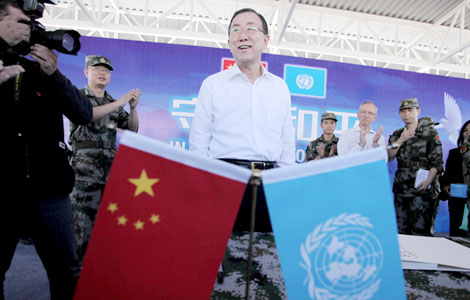Promoting FDI in central, western regions is priority
Updated: 2013-06-05 05:54
By Bao Chang (China Daily)
|
||||||||
With labor costs rising rapidly in coastal areas, more foreign companies looking to inland areas
Promoting foreign direct investment in the middle and western regions of China is a top priority, while in the eastern region the focus is to improve the efficiency of the use of foreign funds, the Ministry of Commerce said on Tuesday.
"In recent years, foreign investment into central region and western region has been growing fast. Many multinational companies have directly entered markets in the western region when investing in China," said Huang Feng, deputy director-general of the ministry's foreign investment administration department.
Data from the ministry show that in 2012, foreign investment to the central and western regions accounted for 17.2 percent of the total nationwide, up 3.4 percentage points year-on-year.
From January to April, China received $38.34 billion in foreign direct investment, up 1.21 percent year-on-year. Of that amount, the western region received $3.11 billion, up 25.7 percent, and the central region received $3.22 billion, up 5.7 percent, according to figures from the ministry.
FDI to the eastern region declined 1.1 percent to $32.01 billion for the first four months.
As labor costs are increasing rapidly in the coastal areas of East China, more foreign companies are looking to the country's western areas.
"Although expanding fast, the investment to the central and western regions are still at a lower level, compared with that in East China. So boosting FDI in the western region is a priority," Huang said, adding that in future, the strategy of foreign capital investment in the eastern region is to improve the quality of utilization.
"To strengthen the western region's competitiveness to attract foreign investment, we need to highlight the industrial advantages in those regions," said Yao Jian, spokesman for the ministry.
Examples include industries that process agricultural products in Jiangxi province and the marine economy and cruise manufacturing industries in Hainan province. These projects are competitive and able to attract more foreign capital, according to Yao.
"The ministry will further improve the investment environment in the central and western regions, providing fiscal support and boosting human resource reserves for foreign investors," said Yao.
"Foreign investment in high-end industries, including electronic information, aerospace, pharmaceutical manufacturing and modern agriculture has started to take shape and some of them even became as developed as those in eastern region," the ministry said.
The service and high-end industries have grown fast due to the backing from foreign investors. In 2012, foreign investment in the service sector was 48.2 percent of the total FDI the country received. And FDI to the transportation equipment and general instruments sectors increased by 17.15 percent and 31.82 percent, respectively, according to the ministry.
"Establishing a cooperation platform between the eastern and western regions is to play a leading role in optimizing regional distribution of foreign capital," said Yao.
"The comprehensive cooperation mechanism has not only promoted industrial upgrading and transition and facilitated the output of advanced management mechanisms in East China, but also enhanced the quality of the use of foreign capital," Yao added.
In a business confidence survey released by the European Union Chamber of Commerce in China and Roland Berger Strategy Consultants last week, 86 percent of companies surveyed said they are considering further investment to expand operations in China, while 41 percent are planning merger and acquisition deals this year.
More than half of European companies are planning to expand business from first-tier cities to second- and third-tier cities in China, with interest growing in the western region.
The survey found that Sichuan tops the list of destinations the companies are shifting their focus to, followed by Guangdong and Chongqing.
Davide Cucino, president of the chamber, said western China is a growing attraction for European companies, although coastal areas still remain key markets.
By the end of the first quarter, 191 Fortune 500 companies had entered Sichuan, bringing direct investment worth more than $10 billion, according to the department of commerce in Sichuan province.
baochang@chinadaily.com.cn
(China Daily 06/05/2013 page14)

 Michelle lays roses at site along Berlin Wall
Michelle lays roses at site along Berlin Wall
 Historic space lecture in Tiangong-1 commences
Historic space lecture in Tiangong-1 commences
 'Sopranos' Star James Gandolfini dead at 51
'Sopranos' Star James Gandolfini dead at 51
 UN: Number of refugees hits 18-year high
UN: Number of refugees hits 18-year high
 Slide: Jet exercises from aircraft carrier
Slide: Jet exercises from aircraft carrier
 Talks establish fishery hotline
Talks establish fishery hotline
 Foreign buyers eye Chinese drones
Foreign buyers eye Chinese drones
 UN chief hails China's peacekeepers
UN chief hails China's peacekeepers
Most Viewed
Editor's Picks

|

|

|

|

|

|
Today's Top News
Shenzhou X astronaut gives lecture today
US told to reassess duties on Chinese paper
Chinese seek greater share of satellite market
Russia rejects Obama's nuke cut proposal
US immigration bill sees Senate breakthrough
Brazilian cities revoke fare hikes
Moody's warns on China's local govt debt
Air quality in major cities drops in May
US Weekly

|

|








